内容紹介
In recent decades Japan has changed from a strongly growing, economically successful nation regarded as prime example of social equality and inclusion, to a nation with a stagnating economy, a shrinking population and a very high proportion of elderly people. Within this, new forms of inequality are emerging and deepening, and a new model of Japan as ‘gap society’ (kakusa shakai) has become common-sense. These new forms of inequality are complex, are caused in different ways by a variety of factors, and require deep-seated reforms in order to remedy them. This book provides a comprehensive overview of inequality in contemporary Japan. It examines inequality in labour and employment, in welfare and family, in education and social mobility, in the urban-rural divide, and concerning immigration, ethnic minorities and gender. The book also considers the widespread anxiety effect of the fear of inequality; and discusses how far these developments in Japan represent a new form of social problem for the wider world.
著者からのコメント
The starting points for this book were an international workshop held at the German Institute for Japanese Studies (DIJ) in March 2013 and an international conference held in Berlin in November of the same year. David Chiavacci from the University of Zurich and I brought together an interdisciplinary group of experts on Japan, to analyse and discuss recent developments in social inequality. We are grateful that all of them stayed loyal to the project and contributed a chapter to this book. The volume comprises new analyses by social anthropologists, sociologists, political scientists, economists, and social geographers which have not been published previously, making the volume a multi-disciplinary and multi-methodological approach to inequality in post-growth Japan.
Please pay special attention to the chapter contributed by my colleague Jun Imai.
外部リンク
〔出版社〕Routledgeの紹介ページ


